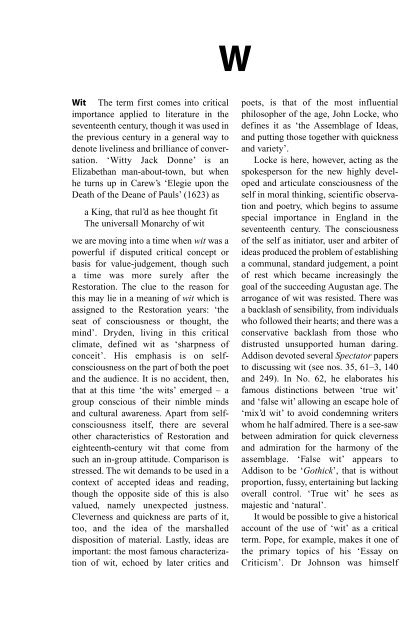The Routledge Dictionary of Literary Terms
The Routledge Dictionary of Literary Terms
The Routledge Dictionary of Literary Terms
Create successful ePaper yourself
Turn your PDF publications into a flip-book with our unique Google optimized e-Paper software.
Wit <strong>The</strong> term first comes into critical<br />
importance applied to literature in the<br />
seventeenth century, though it was used in<br />
the previous century in a general way to<br />
denote liveliness and brilliance <strong>of</strong> conversation.<br />
‘Witty Jack Donne’ is an<br />
Elizabethan man-about-town, but when<br />
he turns up in Carew’s ‘Elegie upon the<br />
Death <strong>of</strong> the Deane <strong>of</strong> Pauls’ (1623) as<br />
a King, that rul’d as hee thought fit<br />
<strong>The</strong> universall Monarchy <strong>of</strong> wit<br />
we are moving into a time when wit was a<br />
powerful if disputed critical concept or<br />
basis for value-judgement, though such<br />
a time was more surely after the<br />
Restoration. <strong>The</strong> clue to the reason for<br />
this may lie in a meaning <strong>of</strong> wit which is<br />
assigned to the Restoration years: ‘the<br />
seat <strong>of</strong> consciousness or thought, the<br />
mind’. Dryden, living in this critical<br />
climate, defined wit as ‘sharpness <strong>of</strong><br />
conceit’. His emphasis is on selfconsciousness<br />
on the part <strong>of</strong> both the poet<br />
and the audience. It is no accident, then,<br />
that at this time ‘the wits’ emerged – a<br />
group conscious <strong>of</strong> their nimble minds<br />
and cultural awareness. Apart from selfconsciousness<br />
itself, there are several<br />
other characteristics <strong>of</strong> Restoration and<br />
eighteenth-century wit that come from<br />
such an in-group attitude. Comparison is<br />
stressed. <strong>The</strong> wit demands to be used in a<br />
context <strong>of</strong> accepted ideas and reading,<br />
though the opposite side <strong>of</strong> this is also<br />
valued, namely unexpected justness.<br />
Cleverness and quickness are parts <strong>of</strong> it,<br />
too, and the idea <strong>of</strong> the marshalled<br />
disposition <strong>of</strong> material. Lastly, ideas are<br />
important: the most famous characterization<br />
<strong>of</strong> wit, echoed by later critics and<br />
W<br />
poets, is that <strong>of</strong> the most influential<br />
philosopher <strong>of</strong> the age, John Locke, who<br />
defines it as ‘the Assemblage <strong>of</strong> Ideas,<br />
and putting those together with quickness<br />
and variety’.<br />
Locke is here, however, acting as the<br />
spokesperson for the new highly developed<br />
and articulate consciousness <strong>of</strong> the<br />
self in moral thinking, scientific observation<br />
and poetry, which begins to assume<br />
special importance in England in the<br />
seventeenth century. <strong>The</strong> consciousness<br />
<strong>of</strong> the self as initiator, user and arbiter <strong>of</strong><br />
ideas produced the problem <strong>of</strong> establishing<br />
a communal, standard judgement, a point<br />
<strong>of</strong> rest which became increasingly the<br />
goal <strong>of</strong> the succeeding Augustan age. <strong>The</strong><br />
arrogance <strong>of</strong> wit was resisted. <strong>The</strong>re was<br />
a backlash <strong>of</strong> sensibility, from individuals<br />
who followed their hearts; and there was a<br />
conservative backlash from those who<br />
distrusted unsupported human daring.<br />
Addison devoted several Spectator papers<br />
to discussing wit (see nos. 35, 61–3, 140<br />
and 249). In No. 62, he elaborates his<br />
famous distinctions between ‘true wit’<br />
and ‘false wit’ allowing an escape hole <strong>of</strong><br />
‘mix’d wit’ to avoid condemning writers<br />
whom he half admired. <strong>The</strong>re is a see-saw<br />
between admiration for quick cleverness<br />
and admiration for the harmony <strong>of</strong> the<br />
assemblage. ‘False wit’ appears to<br />
Addison to be ‘Gothick’, that is without<br />
proportion, fussy, entertaining but lacking<br />
overall control. ‘True wit’ he sees as<br />
majestic and ‘natural’.<br />
It would be possible to give a historical<br />
account <strong>of</strong> the use <strong>of</strong> ‘wit’ as a critical<br />
term. Pope, for example, makes it one <strong>of</strong><br />
the primary topics <strong>of</strong> his ‘Essay on<br />
Criticism’. Dr Johnson was himself

















